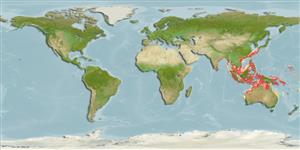Teleostei (teleosts) >
Callionymiformes (Dragonets) >
Callionymidae (Dragonets)
Etymology: Callionymus: Greek, kallion, comparative of kallos = beautiful + Greek, onyma = name; with a better name.
More on author: Fricke.
Environment: milieu / climate zone / depth range / distribution range
Ecology
Marine; demersal; depth range 49 - 148 m (Ref. 42832). Tropical
Indo-West Pacific: Andaman Sea to China, Philippines and New Guinea.
Size / Weight / Age
Maturity: Lm ? range ? - ? cm
Max length : 15.0 cm TL male/unsexed; (Ref. 42832); common length : 12.0 cm TL male/unsexed; (Ref. 42832)
Dorsal spines (total): 4; Dorsal soft rays (total): 9; Anal spines: 0; Anal soft rays: 9. Head and body brown, dorsally with many white-edged dark spots. Ventral sides whitish. Sides with 1 or 2 rows of dark blotches. First dorsal fin in males with many irregular white-edged dark lines. Fin distally blackish in females and young males. Second dorsal fin in males with vertical blackish streaks. Anal fin with 8 basal blackish spots. Caudal, pectoral, and pelvic fins spotted with brown (Ref 42832).
Found on sand and mud bottoms (Ref. 42832). Feeds on crustaceans, worms, and snails (Ref. 42832). Utilized as fish meal; sometimes marketed fresh (Ref. 42832).
Life cycle and mating behavior
Maturity | Reproduction | Spawning | Eggs | Fecundity | Larvae
Fricke, R., 2001. Callionymidae. Dragonets. p. 3549-3571. In K.E. Carpenter and V. Niem (eds.) FAO species identification guide for fishery purposes. The living marine resources of the Western Central Pacific. Vol. 6. Bony fishes part 4 (Labridae to Latimeriidae), estuarine crocodiles. FAO, Rome. (Ref. 42832)
IUCN Red List Status (Ref. 130435: Version 2024-2)
Threat to humans
Harmless
Human uses
Fisheries: minor commercial
Tools
Special reports
Download XML
Internet sources
Estimates based on models
Preferred temperature (Ref.
123201): 21.6 - 28.1, mean 26 °C (based on 376 cells).
Phylogenetic diversity index (Ref.
82804): PD
50 = 0.5000 [Uniqueness, from 0.5 = low to 2.0 = high].
Bayesian length-weight: a=0.00891 (0.00410 - 0.01937), b=2.78 (2.60 - 2.96), in cm total length, based on LWR estimates for this Genus-body shape (Ref.
93245).
Trophic level (Ref.
69278): 3.3 ±0.46 se; based on food items.
Resilience (Ref.
120179): High, minimum population doubling time less than 15 months (Preliminary K or Fecundity.).
Fishing Vulnerability (Ref.
59153): Low vulnerability (10 of 100).
